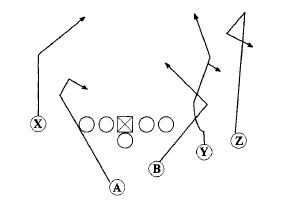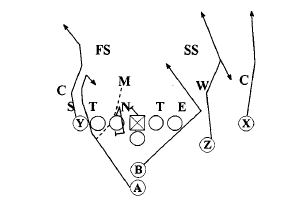Complex Simplicity...Simple Complexity | by Michael
A little more X's and O's for you today.
One of the big questions about Weis moving to the college game has been the complexity associated with a Patriots-style pro offense, and the concern that it may be too difficult to implement at a college program. But take a look at what this frequent Pats' opponent had to say in an August 2002 article entitled "Stopping the Patriots offense can cause headaches":
"I think Charlie Weis is one of the best; he has great schemes....they will run the same plays but they would do them from so many different formations." - Dolphins linebacker Zach Thomas
We've touched on this a little bit in previous posts, but let's take another look, starting with the lingo. Charlie & the Patriots' system isn't so much dependent on rote memorization, but rather just learning some basic foundational principles, and building up from there. Brady Quinn compared it to "learning a different language", more of a cultural immersion experience than a repetitive, linear Berlitz course. At the end of the process, you're thinking, conversing and comprehending as a matter of second nature, and able to combine and create within the language -- as opposed to having simply learned a long, but ultimately limited list of individual phrases.
The clear advantage to a language system like this is that you can easily take the subject/predicate of the sentence (the base play call), dress it up with different adjectives and adverbs (the personnel group, the formation, shifting/motion, etc), and end up with a variety of appearances. Of course, if you want to make the system complex, you certainly can. Jon Gruden's Tampa Bay playbook features 800 different formations and his quarterbacks leave the huddle with three options in a playcall. To that extent, I'm sure that the Irish version of Weis's NFL playbook has been trimmed down considerably, especially the pages dedicated to WR/FB/TE alignments, motions and pass protection schemes. In sum, the underlying system is elementary and fairly narrow in scope; yet the output is what seems like a confusing blizzard of different plays.
To be sure, Weis hasn't invented the wheel with this system; Jeff Tedford has a similar approach, as do guys like Norm Chow, Bobby Petrino and Al Borges, among others.
Larry Coker, for example, has applied the same at the University of Miami. Below you will find eight different plays Coker discussed at a 2004 Nike Coach of the Year clinic. All of these plays were drawn up to take advantage of TE Kellen Winslow's athleticism; notice the underlying pass concept(s) behind all of them. Each look/formation is different, but the pass patterns are all roughly the same.
(Note: All of these diagrams were taken from the clinic material available at the link above.)
| • The first one we'll look at is out of a basic I-formation. Pretty simple concept, I think everyone would agree. The TE reads the free safety and runs either a comeback or a seam route, if the deep middle is open. |  |
| • Now let's look at a package and formation with two TEs. It's an identical concept; the second TE steps off the line, goes in motion and runs the same angle route previously run by the FB. |  |
| • Now simply replace that TE with a slot WR. Same idea out of yet another look. |  |
| • It also works out when you empty the backfield. This concept works great with backs like Reggie Bush, and hopefully we'll be able to use Justin Hoskins in a similar capacity. The lone back motions to the slot and runs the same checkdown; everything else remains the same. |  |
| • If you have an athletic TE, you can mix it up even more by putting him in the slot. Coker had Winslow, and Weis used Daniel Graham in a similar manner with New England. Can Weis do the same with the Irish TEs? Possibly. |  |
| • In this twins set, notice how Coker tries to isolate the athletic TE while the other WR lines up in the slot. It's about match-ups, something that Weis has talked about himself. There are slight variations to the outside routes in this play but it's still essentially the same concept. |  |
| • Finally, here's another look designed to take advantage of a versatile back who can line up in the slot. As you can see, not much else is different. |  |
So what do you think's easier...learning one concept and applying it to eight different situations, or learning eight unique plays?
Here's Norm Chow to sum it up for us (from Coaching the Passing Game: By the Experts):
With that in mind at USC on the dropback passing game, we will have nine passes... Everyone has to remember the pass routes. We have nine basic patterns. We teach four one day and five the next day. That is all we have. We feel very strongly about this. We are going to keep it as simple as we can, so our kids will go out on the field confident that we are going to make the play, and we are going to know what we are doing... We have one strongside vertical route, one middle vertical, and one weakside vertical. We have two horizontal-stretch routes, a man route, four verticals, and a cover 2 beater. That is all we do. We attack everyone we play with these plays. Our kids know these plays by the second day of practice.
